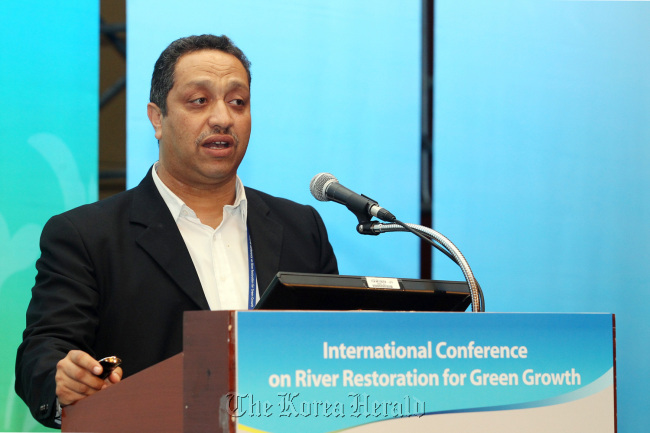This article was contributed by the Korea Water Resources Corp. to mark the opening of the 2012 World River Forum in Daegu on Wednesday. ― Ed.
It may be fair to say that economic growth has been given priority over environmental conservation in many parts of the world. Since 2009, the four-river restoration project has been initiated as a part of the green growth imitative developed by the Korean government.
The project is targeting the main rivers ― Han, Geum, Nakdong and Yeongsan ― of the peninsula and irrigates, in fact, most of the territory of South Korea. Natural resources can be seen as a capital asset belonging to a general portfolio, which is comprised of other assets and capital, including material, financial, human and social. Managing this portfolio in a good and sustainable manner to maximize its returns and benefits over time is good investment.
It is also central to sustainable development. In a holistic approach combining social, environmental and economic demands, the project is defined to provide water security, flood control and ecosystem vitality.
Korea faces many challenges which are now in front of modern societies. Urbanization and densification, economic development combined with eco-friendly approach, adaptation to climate change, natural disasters prevention, ecological quality and preservation of nature.
The four-river restoration project developed as a stimulus package to be seen as a global and regional answer to the 21st century’s major challenges. Of course all of the previous aspects can’t be achieved simultaneously and may appear as competitors.
Integrated water resources management in a multidisciplinary approach by developing real pro-active strategies to sustain a coherent development based on a social and economic consensus is a big challenge. The “four rivers” restoration project has, among its five key objectives, securing sufficient water resources against water scarcity, implementing comprehensive flood control measures, and improving water quality whilst restoring the river-basin ecosystems. It is encouraging to observe that each of these objectives not only addresses a vital ecological scarcity, but that actions planned will also serve as useful forms of adaptation to the onset of climate change.
The Korean society adopts a pioneer unique approach, linking social, economic and ecological dimensions. This approach represents a major long-term challenge not only for the Korean society but for all modern societies. The absence of measures standard, the recent experience and knowledge of the magnitude of such projects, combined with non-equivalent past experience and the instability of the international economic environment are major challenges of such project.
The degree of success will be difficult to predict but it is essential to refer to this initiative as a pioneer step towards developing new concepts in presenting the green growth strategy as an innovative development approach involving a fundamental shift in the country’s growth paradigm, from “quantitative growth” to “qualitative growth.”
The four-river restoration project is also addressing the ecological environment through the water quality. The approach is based on the improvement of agricultural methods with a significant reduction in the use of pesticides and on equipment dedicated to water treatment. This approach is essential in order to anticipate and avoid a situation which is now rapidly expanding in many countries and costing billions of dollars a year in developed countries and is set to rise in China and India as farmers race to increase food production,
“Pollution from farm pesticides and fertilizers is often diffuse, making it hard to pin down exactly where it’s coming from,” Kevin Parris, author of a report by the Paris-based organization, said in an interview in Marseille. “In some big agricultural countries in Europe, like parts of France, Spain and the U.K., the situation is deteriorating.” Such products have now completely affected for decades the groundwater resources and rivers. The consequences are unfortunately now very well known with some red tides and green algae phenomena.
The growing complexity of our cities contributes to increased vulnerability during extreme situations. The four-river restoration project has clearly identified the risks of flooding associated with a return period of 200 years and has developed a coherent protection scheme in response. The 200 years event has been determined according to our actual knowledge from existing records.
Of course, the climate evolution may generate changes and affect the magnitude of extreme events that may become more frequent. In such cases, the protection scheme could not be completely effective and part of the cities could be affected by flooding. The project, by taking into account this hypothesis and by the continuous monitoring that will be implemented after the completion of the works, will be able to anticipate and give diagnostic predictions about a potential impact. This step is fundamental in the process for developing a culture about risk, which is the most efficient way to provide safety to citizens.
By launching the four-river restoration project, which is large in size and potential impacts, Korean society has made the choice for a new strategy of development that integrates some of the key challenges of the 21st century: climate change, water security and sustainability. With their willingness to review their development paradigm, Korea appears clearly to be a leading nation. The choice to move towards a more resilient environment represents a major challenge for all of society, and contributes to an elaborate and original concept that will be a future reference for inspiration.
 |
Nidal Salim |
By Nidal Salim
The author is director of the Global Institute for Water Environment and Health. ― Ed.




![[Herald Interview] 'Trump will use tariffs as first line of defense for American manufacturing'](http://res.heraldm.com/phpwas/restmb_idxmake.php?idx=644&simg=/content/image/2024/11/26/20241126050017_0.jpg)

![[Health and care] Getting cancer young: Why cancer isn’t just an older person’s battle](http://res.heraldm.com/phpwas/restmb_idxmake.php?idx=644&simg=/content/image/2024/11/26/20241126050043_0.jpg)

